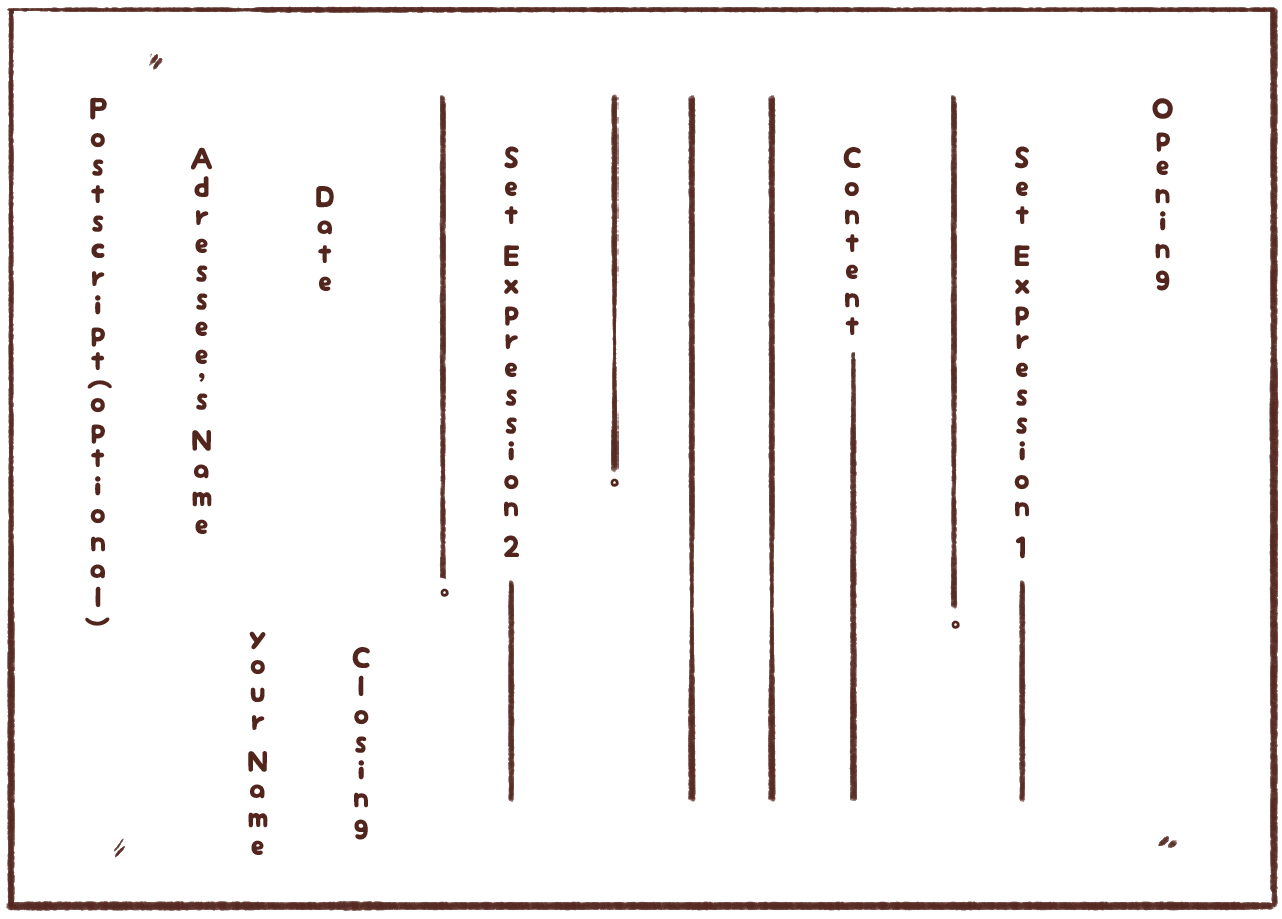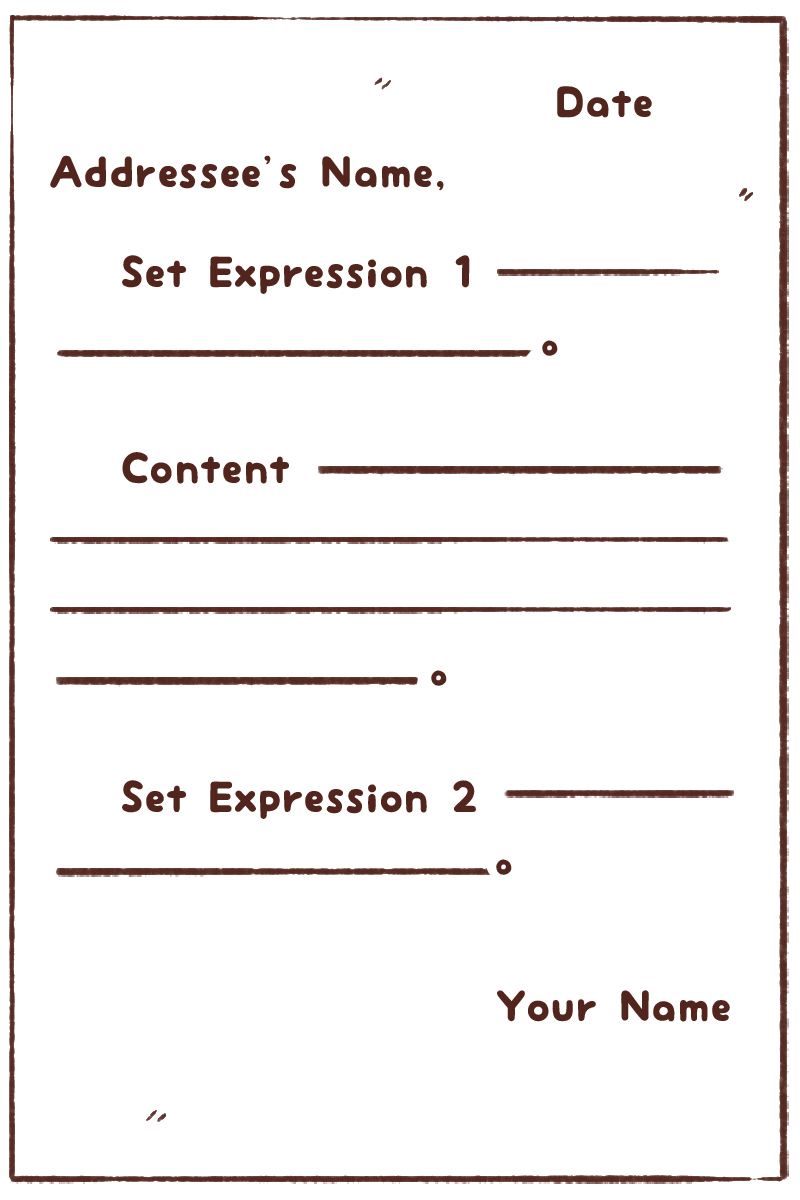Writing a letter in Japanese is quite the epic topic. It's sadly not as easy as writing something, stuffing it in an envelope, stamping it, and sending it. Japanese letters require you to think about certain formalities, set expressions, styles of writing, and even relationships between you and the person you're writing to. It's so complicated and convoluted that even Japanese people will buy books on the subject so that they can "read up on" and study the latest letter writing rules. Don't feel bad if you feel lost.
The goal of this article is to help you to understand Japanese letters. It will take a little more research and studying to be able to write a letter in Japanese, but I think I'll be covering the difficult part. After reading this article, I want you to understand things like the relationship between you and the person you're writing to, the format of a Japanese letter (both vertical and horizontal), how to write the address on the envelope, as well as the concept of "set expressions." This will give you the tools to write a letter, make things less confusing, and eventually get you to the point where you should be able to piece together a Japanese letter on your own (resources included in the last section of this article).
Let's get straight into the first thing you must think about even before you pick up that pen and paper. Wait, I mean, go to your keyboard and monitor, relationships.
Relationships: AKA Who Are You Writing To?

In Japanese, hierarchy is much more important than in many other countries. You have the senpai-kohai relationship. Then you have teacher vs. student, boss vs. minion, older people vs. younger people, and the list goes on and on. On top of this, relationship statuses change when you're asking for a request, but this (and many other things) will depend on how close you are to the other person. Relationships, your closeness, and where you stand in the hierarchy of said relationship dictate how you act and speak with that other person. Of course, this carries over to letters as well.
I am going to simplify it a bit for you though. In general, there's going to be three types of letters. They are:
Informal: Friends, Senpai, People below you
Neutral: Teachers, Friends you are requesting something of, Superiors
Formal: People you don't know, Superiors you are requesting something of
You may have noticed some patterns here. Informal relationships are people of a similar age, aka people who are on the same hierarchy level as you. Then, there's neutral (which is really just regular-polite level) which has teachers and other superiors whom you have at least a moderately close relationship with, though friends that you are requesting something of get bumped up to this rung (because you have to be nice if you're asking for something). Lastly, there's formal, which includes people you don't have a close relationship with (people you don't know), as well as superiors that you're asking something of. Asking something of someone automatically bumps them up to the next rung, as a rule of thumb.
Of course, as long as you stay in the Neutral or Formal levels, you'll probably always be okay, so that's what I'll be sticking with in these articles as well. Informal is informal, and doesn't really need to follow so many of the rules that I'll be laying out here during this series.
The Materials

Now that you know who you're writing to, it's time to figure out what materials you need to use. I think a lot of this is just common sense, but just in case it isn't, I've summarized and simplified a list provided by the (excellent) textbook, Writing Letters In Japanese.
- In general, white stationary without any pictures is most preferred.
- Business letters are usually written horizontally via a word processor.
- Personal letters to superiors should be written vertically on white stationary (hand written).
- For superiors, use a white envelope.
- Write in pen, using black or blue ink.
- Don't write with pencils or markers.
- Postcards should only be used in informal occasions, or occasions in that call for postcards (like New Years).
Once you've figured out your materials (based on who you're writing to), it's time to learn how to use these materials. Sadly, not all of it is as simple as you might think. There are rules, Smokey!
Japanese Letter Formatting Rules
I will cover two types of letter: Vertical and Horizontal. This refers to how you're writing your text. Does it go up to down or does it go right to left? Depending on which one you choose, there are a few differences you need to take note of.
Vertical Letters
These are the most personal. I suppose you're putting a lot more work into this kind, because in general you're writing them out by hand. Horizontal rule letters feel a little colder and less personal, though I think that's changing. Usually, though, you can't go wrong with a vertical letter, as it's the standard style for letter writing in Japan.

As you can see there are various parts, and the positioning of each is important.
Opening: The opening word consists of a set word, kind of like the word "Dear…" that goes at the beginning of English letters. In Japanese, this would be haikei 拝啓 or zenryaku 前略. These actually pair with the closing section, so be careful!
Set Expression #1: Right at the beginning of the letter there should be a set expression. This could be one of many predetermined topics or phrases, which are usually about weather, the season, health of the addressee, and so on and so forth. Certain topics will have certain opening set expressions as well, but we'll go more into that later.
Content: This is where you actually write your letter and say the things you want to say. Notice how this is the only non-predetermined section out of so many? It's weird.
Set Expression #2: After you finish saying what you want to say, it's time for another set expression. This will usually be about the addressee's health or good wishes for them.
Closing: This is like "sincerely…" in English letters. Unlike that, however, it is paired with the opening. 拝啓 goes with the closing greeting keigu 敬具. 前略 goes with the closing sousou 草々. No mixing and matching.
Date: This is written a little lower than the text to its right. Use the Japanese numeral system for vertical letters.
Your Name: This is where you write your name. Put it down to the bottom of the column.
Addressee's Name: This goes to the left of the date and your name, but higher than the date, and lower than all the text to the right.
PostScript (Optional): This is the P.S. portion of the letter. In Japanese, this is tsuishin 追伸 or nishin 二伸, and is written to the left of the addressee's name, lined up with the main text. This is a little informal, though, so don't use it if you can help yourself.
As you can see, there's a lot to consider even before you write any content. Luckily, horizontal letters are a lot simpler.
Horizontal Letters
Generally used in business sorts of situations, horizontal letters are mostly typed out and a lot simpler.

Date: Goes in the top right. It's written using Arabic numerals since it's being written horizontally. 12月25日, for example.
Addressee's Name: This is where you put the name of the person you're writing to. As with all letters, don't forget their name honorific!
Set Expression #1: Here's where the first set expression will go.
Content: This is where the content of your letter will go.
Set Expression #2: One more set expression for the addressee's well being and health.
Your Name: This is where you sign your name, horizontally. Might be good to sign it with a pen instead of with the word processor, just to be a little more polite.
Horizontal letters are easier, but they can be considered rude if you send them in the wrong situations. Of course, email is a whole other thing (it's all horizontal there), and I think it's causing the mindset to shift a bit on this. Still, though, vertical is the default go-to for writing letters (especially by hand), so be sure learn about it even though this one is easier.
Envelopes And Addresses
The address system in Japan is quite different from America and much of the rest of the world. You'll want to know about that before sending a letter, otherwise it may not get to the desired location (that being said, the Japanese postal system is baller). Once you know the address, though, there are some rules as to where you should be putting the mailing address, return address, and stamp.
Vertical Envelopes
This is the tall type envelope which you will often see in Japan. It's good for vertically written letters, as you can crease your letter parallel to the lines you're writing.

As you can see there are a few different things compared to the envelopes you might be used to. First off, you'll want to put the postal code in boxes provided. Then, on the front of the envelope, you'll want to put the address on the right side (written vertically) and the addressee's name on the left, written in slightly bigger letters than the address to help differentiate. On the flap side of the envelope you should write the return address. Your name and address should go on the left side in the same format as the addressee's name and address (though size isn't going to matter as much), and your postal code should go in the boxes if they're provided.
Horizontal Envelopes
With horizontal envelopes, there are a couple ways to do it.
- You can turn the envelope sideways so it's taller, and write the address in the same way you'd write it with a vertical envelope.
- You can write things horizontally. Just like the vertical envelope, the addressee's address goes on the front, with their address on top and their name written bigger below. If the boxes for the postal code are posted vertically, turn the envelope and write it in the direction they're printed (horizontally). On the back of the envelope (flap side) you can put your address and name at the bottom.
A lot of the rules carry over from vertical envelopes, so this should be a little easier. So what about when you're sending a letter to Japan?
Sending Letters To Japan From Overseas
When you are sending a letter to Japan from outside of Japan, you can write the address in romaji (though Japanese is preferred, if you can), and write it in the format that's normally accepted in your country. Just be sure to write "JAPAN" at the bottom of the addressee's address so they know to send it there!
Opening Set Expressions
This is perhaps the most difficult section of all when it comes to writing letters in Japanese. Luckily, these are set expressions, meaning you can just look them up, use them, and gone on with your life. The tricky part comes when you have to come up with some of your own (in certain specific situations), though we're going to just ignore that for now.
The first set of set expressions is the one that comes before the start of your actual content. It generally has to do with weather, the season, or health of the addressee. There are expressions for each month, season, as well as different opening greetings for various inquisitions on the addressee's health. Here are some examples, though there are many more set expressions worth knowing (or knowing where to find, which I'll go over at the end).
January:
- 寒さひとしお 身にしみる 今日このごろ…
- In this time of piercing cold…
- 新春とは 申しながら、まだまだ 寒さが 続いておりますが…
- While it is the New Year, the cold continues.
Spring:
- 春の 日うららかな 今日このごろ…
- In this time of beautiful spring days…
- 日本はあたたかくなっているころでしょう…
- I guess it must be getting warmer in Japan…
August:
- 厳しい 残暑が 続いておりますが…
- The oppressive heat continues to linger…
December:
- 今年も 押し 迫りましたが…
- This year is drawing to a close… (used after Dec 20)
Health Related:
- いかがお 過ごしていらしゃいますか?
- How have you been?
- 私もおかげさまで 元気にしております…
- Fortunately I am doing well (thanks to your help)…
Writing A Reply To A Letter
- お 手紙ありがとうございました…
- Thank you for your letter…
These set expressions are only a drop in the bucket. There are at least several set expressions for each month, season, and situation, and there are probably more out there. The thing about set expressions is you are expected to write with said set expressions, otherwise your letter isn't going to come off as polite. While creativity is encouraged in Western letters, using some set expression rules is more important in Japanese, which makes things both harder and easier.
Closing Set Expressions
After your main content you have to go back into set expressions. There are fewer of these, but it's still basically the same thing as the opening ones. Here are some examples:
Making A Request
- どうかよろしくお 願い 致します。
- Kindly look after this matter for me.
Give My regards
- 奥様に 宜しくお 願いします
- Please give my regards to your wife.
Good Health
- お 寒さの 折からお 体をお 大切に
- Please take care of yourself since it's cold.
Request A Reply
- お 返事を 待ちしております
- I look forward to your reply.
I think closing set expressions are a little simpler than the opening ones, but they're all basically the same thing and you'll see the same ones over and over a lot.
Where To Go From Here?

So as you can see, writing letters in Japanese is a big ordeal, though once you learn all the rules and do a little practice it's not all that bad. In fact, it's very set in stone, meaning that as long as you follow the rules you'll be able to write a great letter in Japanese.
The next step, I think, is to take a look at examples. Writing letters in Japanese definitely takes an intermediate or advanced knowledge of the language, so if you possess said knowledge and want an English textbook, I'd recommend Writing Letters In Japanese. It contains plenty of example letters as well as lessons going over all of them to help you get your letter writing skills up to snuff. Alternatively, if you're fairly advanced in Japanese, the Japanese website Midori-Japan's 手紙の書き方 will do the trick. This site includes many example letters for many different and often specific situations as well as a list of set expressions that you can pull from. Basically, everything you need to template out a proper Japanese letter.
I hope this article and those sources help you to get started writing letters in Japanese! It's a crazy letter writing world over there, but once you get your foot in the proverbial letter-writing door it become easier. I want to write more on this topic soon, including examples for plenty of different letter-writing situations, but we'll see if it's next week or a week in the future to come. Writing letters in Japanese is a huge topic, as I think everyone has come to understand so long as you've read to this point.
